Automotive Steering Sensor Market Size
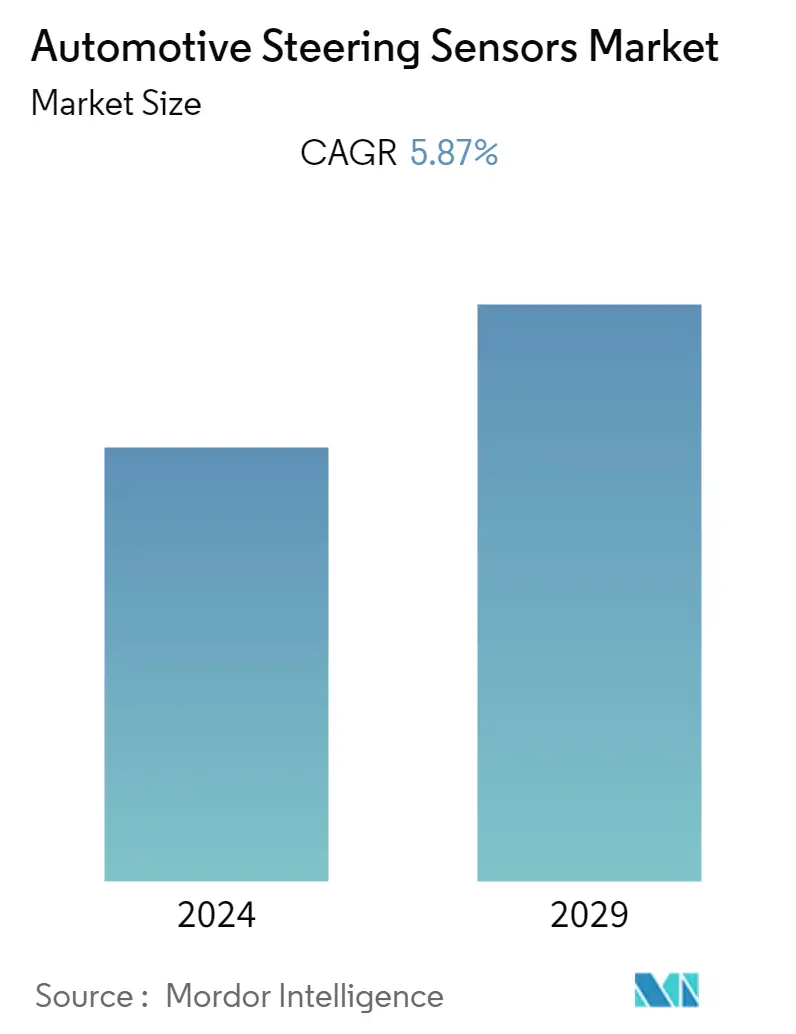
| Study Period | 2019 - 2029 |
| Base Year For Estimation | 2023 |
| CAGR | 5.87 % |
| Fastest Growing Market | Asia-Pacific |
| Largest Market | Asia-Pacific |
| Market Concentration | High |
Major Players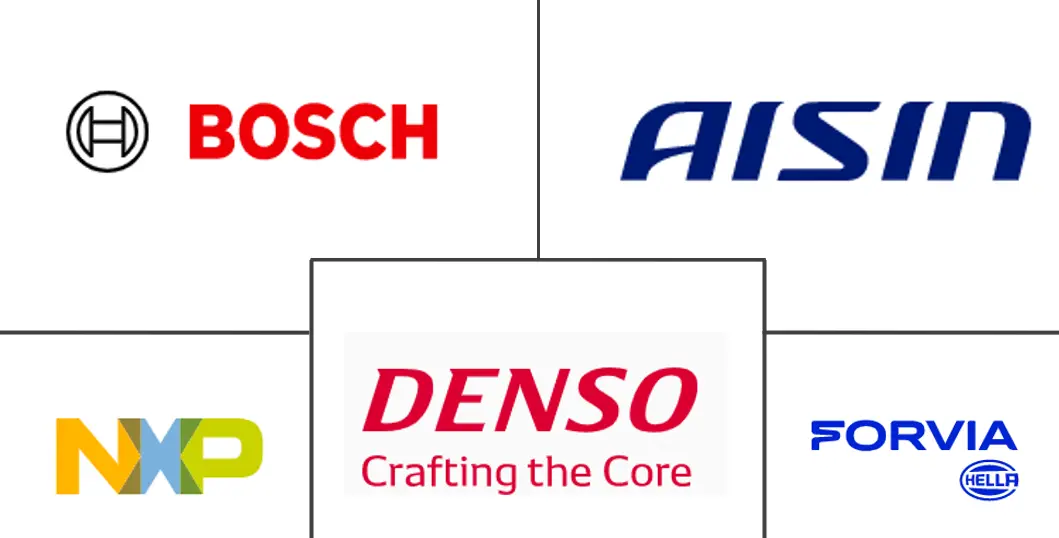
*Disclaimer: Major Players sorted in no particular order |
Automotive Steering Sensor Market Analysis
The automotive steering sensors market is currently valued at USD 9.30 billion. It is expected to reach USD 13.23 billion in the next five years, registering a CAGR of 5.87% during the forecast period.
COVID-19 hurt almost all segments of the automotive industry, including the automotive steering sensors market. In addition, due to lockdowns and halts in production, the demand for automotive steering sensors plummeted. However, the automotive industry witnessed significant growth in terms of production in 2021, which is likely to increase the demand for steering sensors over the forecast period. With the situation returning to normalcy, the heavy commercial vehicle segment is growing, which will likely help the automotive steering sensor market grow during the forecast period.
The automotive industry's recent shift in attention to technical developments such as electrification and autonomous driving has raised the demand for steering sensors. At the same time, the manufacturers' preference for integrating position sensors into vehicles suggests that the market will continue to grow. Autonomous vehicles (especially level 4 and level 5 vehicles) that feature self-driving systems generally process huge amounts of data to give feedback to the steering system and drive smoothly, clear obstacles, and perform turning maneuvers according to traffic signs. Due to this, it is expected that a larger number of sensors need to be incorporated into these types of vehicles, which is expected to drive the market for this segment.
There is growing consumer demand for new safety systems and technologies. Automotive manufacturers have been prompted to equip their vehicles with driver assistance systems, particularly steering assistance systems, as passenger safety concerns have grown. Such factors are driving the demand for steering sensors.
Furthermore, the adoption of stringent fuel efficiency standards by the government and international safety measures are seen as major drivers for the expansion and development of advanced steering systems. The presence of multiple steering sensors in electric power steering (EPS) systems provides the driver with extra safety benefits.
Owing to the aforementioned factors, the automotive steering sensor market is expected to grow significantly during the forecast period.
Automotive Steering Sensor Market Trends
Torque Sensors Experience the Highest Demand
Torque sensors measure the steering torque applied by the driver. The vehicle's electronic control units receive the input from the torque sensor and the motor, or the pump applies the required torque back or assistance on the steering column.
The torque sensor is utilized in automobiles' electronic and hydraulic power steering systems. Nowadays, all cars come with either hydraulic power steering or electronic power steering. As a result, the torque and angle sensor market is expected to flourish in the forecast period due to an increase in global demand for power steering systems.
With growing advancements in technology, sensor products have also been consistently upgraded and improved in the automotive industry. To cater to the market, many OEMs and others are investing in research and development. For instance,
- In May 2022, Nexteer Automotive and Continental AG jointly expanded their two new software functions that provide backup safety layers for all variants of Electric Power Steering and Steer-by-Wire systems and across all driving automation (levels 1 - 5).
- In October 2021, Nexteer Automotive announced the addition of its new modular column-assist EPS system (mCEPS) to its electric power steering (EPS) portfolio, which is designed to fulfill the needs of a wide range of OEMs. Nexteer's high-performance torque and rotation angle sensors are custom-developed to deliver superior noise, vibration, and harshness (NVH) performance and a smooth and precise steering feel, allowing drivers to feel more connected to the road.
- In July 2021, UD Trucks Corp. announced that UD Active Steering, a groundbreaking technology that dramatically enhances steering precision and driver comfort, will be offered in Japan on heavy-duty flagship Quon models. An electric motor is installed above the hydraulic steering gear in UD Active Steering to give additional torque when needed. The electronic control unit (ECU) on the electric motor gets input from sensors all over the truck every 2,000 seconds, monitoring the driving environment and the driver's actions.
Such improved sensor products for torque sensors are expected to witness increasing adoption by automakers during the forecast period.
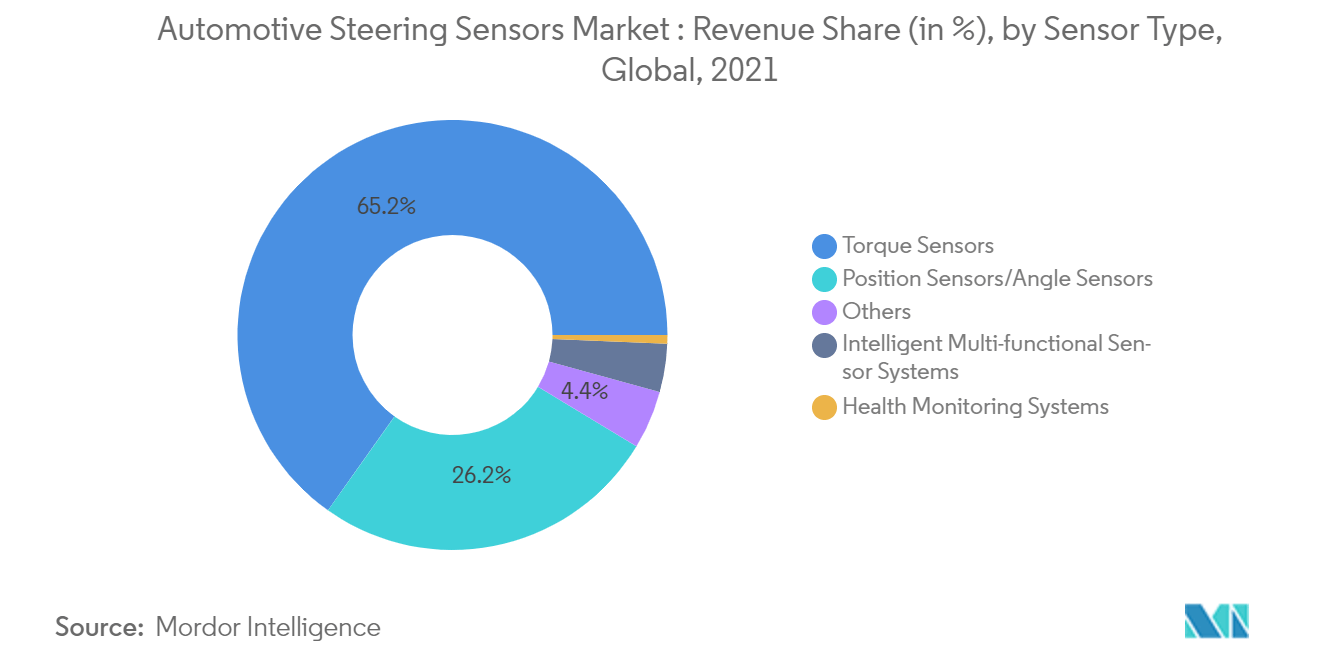
Asia-Pacific Holds a Significant Share
The Asia-Pacific region is expected to become the major market for the manufacture of these systems, with India, Japan, and China moving toward becoming manufacturing hubs for automotive components and sourcing the same to countries such as the United States and Germany.
The automotive industry in Asia-Pacific has been very dynamic over the past few years, owing to the increasing per capita income of the middle-class population and cost advantages for original equipment manufacturers (OEMs). The region is known for producing compact and cost-effective cars and comprises some of the fastest-developing economies of the world, including China and India.
China is dominating the Asia-Pacific automotive steering sensors market in the Asia-Pacific region. China is a significant vehicle market in the Asia-Pacific region. Furthermore, the country dominates the Asia-Pacific automotive sensors industry. This is due to increased acceptance of car safety measures as well as a rise in advanced technology for safety such as ESC, Advanced Driver Assistance Systems (ADAS), etc. In April 2022, the increased frequency of COVID incidences in China created challenges for market players and put negative pressure on the Chinese economy. During this time, the automobile industry and supply chain were pushed to the ultimate challenge. Furthermore, some of the major automakers shut down production and faced enormous logistical challenges, resulting in a collapse in delivery capacity.
The main factors influencing the growth of the Indian automotive steering sensors market include an increase in demand for motor vehicles across the country due to an increase in consumer disposable income and an increase in demand for fuel-efficient automobiles. Other factors that are expected to have a significant influence on the market over the forecast period include an increase in customer desire for easy driving and agility, the high cost of power steering systems, and drive-by-wire technology.
Companies involved in the supply and distribution of steering sensors are looking forward to widespread expansion in other potential markets. Several OEMs are collaborating with automakers to improve their goods. Sensor items have also been continually upgraded as technology has advanced. For instance,
- In January 2022, as a part of the consolidation of its operations in the Indian market, ZF acquired a majority stake in the Rane TRW Steering Systems joint venture with the Rane Group. The new joint venture will operate under the name of ZF Rane Automotive India and produce steering systems for commercial vehicles.
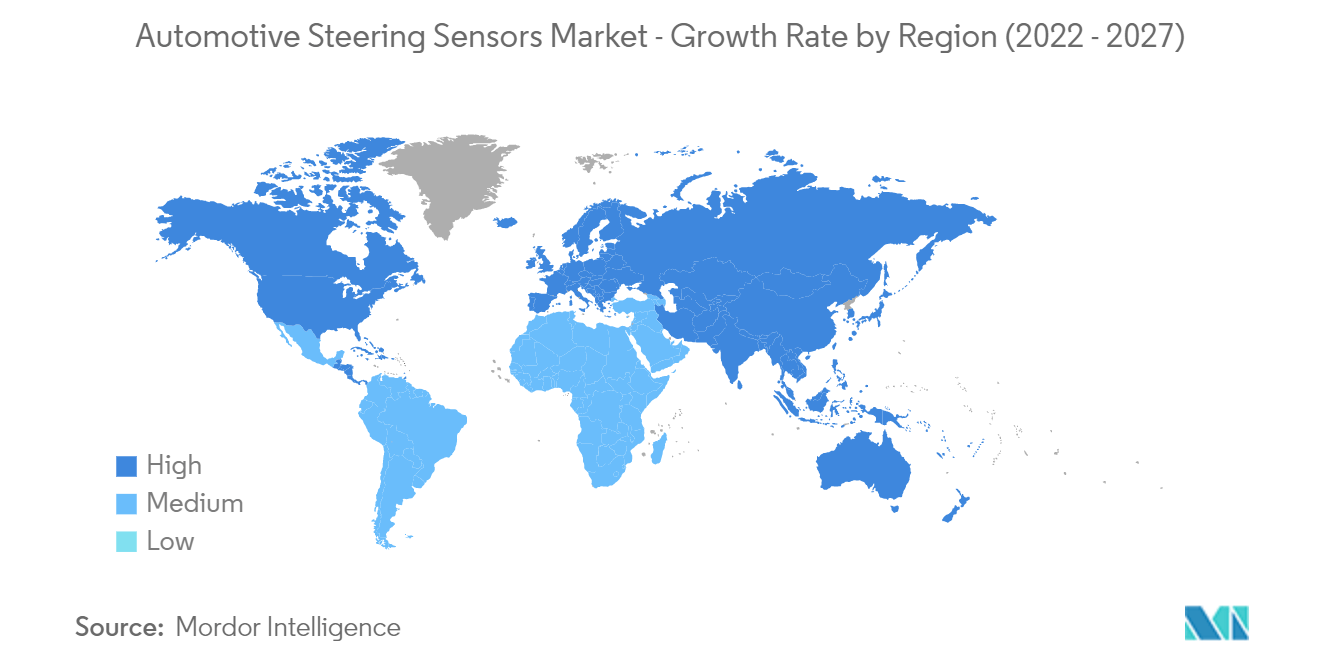
Automotive Steering Sensor Industry Overview
The automotive steering sensors market is dominated by several players, such as Robert Bosch GmbH, Continental AG, DENSO Corporation, HELLA GmbH & Co. KgaA, and NXP Semiconductor. The automotive steering sensors market in the region has undergone a lot of mergers and acquisitions, making the top-five players significant contributors to the steering sensors market.
- In January 2022, Bosch and the Volkswagen Group subsidiary Cariad are collaborating to achieve this objective and have agreed to form an extensive partnership. The companies want to make partially and highly automated driving suitable for volume production and thus available to the broad mass of consumers. For the vehicles sold under the Volkswagen Group brands, the alliance aims to make functions available that will allow drivers to temporarily take their hands off the steering wheel.
- In August 2021, Faurecia, a global automotive supplier headquartered in Auburn Hills, North America, and Hella KGaA Hueck & Co, a German-based company with a similar focus on automotive engineering innovation, came together under a strategic merger to become the seventh-largest automotive supplier across the world. This combination builds on Hella's energy management, sensors, and actuators and Faurecia's portfolio of hydrogen system solutions and hybrid systems.
Automotive Steering Sensor Market Leaders
-
Robert Bosch GmbH
-
DENSO Corporation
-
HELLA GmbH & Co. KgaA
-
AISIN CORPORATION
-
NXP Semiconductors N.V.
*Disclaimer: Major Players sorted in no particular order
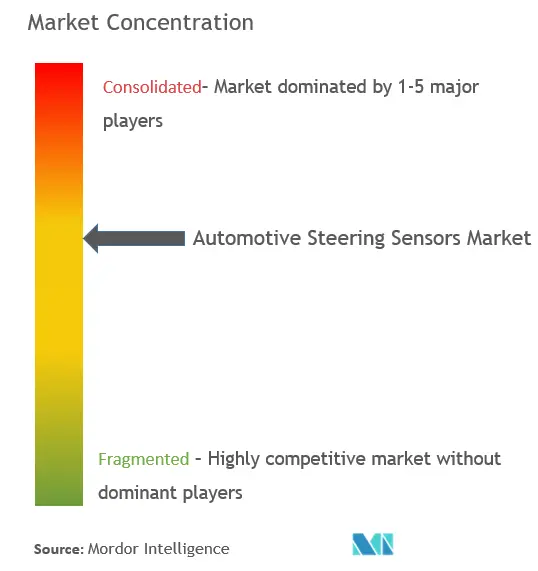
Automotive Steering Sensor Market News
- October 2022: Hitachi Astemo Co. Ltd developed a prototype of a steering device in a steer-by-wire system that eliminates the conventional steering wheel.
- July 2022: TDK Corporation developed a TAS4240 small analog angle sensor with tunnel-magnetoresistance (TMR) for automobiles and industrial equipment. For automotive applications, the TAS4240 is expected to be used as a sensor that detects the angle and position of brushless DC motors and permanent-magnet motors used in power steering systems, brake boosters, and other applications.
- January 2022: Tokai Rika Co. Ltd (Tokai Rika) announced the development of a "steer-by-wire control unit" that is compatible with steer-by-wire systems that send steering commands to tires through electric signals.
- December 2021: Denso Corporation announced the supply of Yaw Rate Sensors to Lexus Flagship models for 2022. The sensor will be equipped in Lexus models like Lexus LC500, Lexus LC500H, Lexus RC300, and Lexus RC300H.
- August 2021: ZF Friedrichshafen AG demonstrated a multifunctional driver assistance system that integrates adaptive cruise control (ACC), lane change assist, and ESP capability. With its sophisticated 360-degree environmental sensing system using short-range radar sensors on the four corners of the vehicle, it allows for safe, semi-autonomous overtaking maneuvers.
Automotive Steering Sensor Market Report - Table of Contents
1. INTRODUCTION
- 1.1 Study Assumptions
- 1.2 Scope of the Study
2. RESEARCH METHODOLOGY
3. EXECUTIVE SUMMARY
4. MARKET DYNAMICS
- 4.1 Market Drivers
- 4.2 Market Restraints
-
4.3 Porter's Five Forces Analysis
- 4.3.1 Threat of New Entrants
- 4.3.2 Bargaining Power of Buyers/Consumers
- 4.3.3 Bargaining Power of Suppliers
- 4.3.4 Threat of Substitute Products
- 4.3.5 Intensity of Competitive Rivalry
5. MARKET SEGMENTATION (Market Size by Value - USD million)
-
5.1 Sensor Type
- 5.1.1 Health Monitoring Systems
- 5.1.2 Torque Sensors
- 5.1.3 Intelligent Multi-functional Sensor Systems
- 5.1.4 Position Sensors/Angle Sensors
- 5.1.5 Other Sensor Types
-
5.2 Vehicle Type
- 5.2.1 Passenger Cars
- 5.2.2 Light Commercial Vehicles
- 5.2.3 Heavy Commercial Vehicles
-
5.3 Technology
- 5.3.1 Contacting
- 5.3.2 Magnetic
-
5.4 Geography
- 5.4.1 North America
- 5.4.1.1 United States
- 5.4.1.2 Canada
- 5.4.1.3 Mexico
- 5.4.1.4 Rest of North America
- 5.4.2 Europe
- 5.4.2.1 Germany
- 5.4.2.2 United Kingdom
- 5.4.2.3 France
- 5.4.2.4 Russia
- 5.4.2.5 Rest of Europe
- 5.4.3 Asia-Pacific
- 5.4.3.1 India
- 5.4.3.2 China
- 5.4.3.3 Japan
- 5.4.3.4 South Korea
- 5.4.3.5 Rest of Asia-Pacific
- 5.4.4 South America
- 5.4.4.1 Brazil
- 5.4.4.2 Argentina
- 5.4.4.3 Rest of South America
- 5.4.5 Middle East and Africa
- 5.4.5.1 United Arab Emirates
- 5.4.5.2 Saudi Arabia
- 5.4.5.3 Rest of Middle East and Africa
6. COMPETITIVE LANDSCAPE
- 6.1 Vendor Market Share
-
6.2 Company Profiles*
- 6.2.1 Robert Bosch GmbH
- 6.2.2 DENSO Corporation
- 6.2.3 HELLA GmbH & Co. KgaA
- 6.2.4 Methode Electronics Inc.
- 6.2.5 Continental AG
- 6.2.6 Honeywell Inc.
- 6.2.7 Infineon Technology
- 6.2.8 NXP Semiconductors N.V.
- 6.2.9 Sensata Technologies
- 6.2.10 Hitachi Metals
7. MARKET OPPORTUNITIES AND FUTURE TRENDS
** Subject To AvailablityAutomotive Steering Sensor Industry Segmentation
Steering sensors are designed for monitoring and operation of the steering system and driver monitoring purposes. These steering sensors are located in the steering column and help to send crucial data regarding drivers' drowsiness, wheel angle, and wheel positioning to the computer onboard the car.
The Automotive Steering Sensors Market is segmented by Sensor Type (Health Monitoring Systems, Torque Sensors, Intelligent Multi-functional Sensor Systems, Position Sensors/Angle Sensors, and Other Sensor Types), Vehicle Type (Passenger Cars, Light Commercial Vehicles, and Heavy Commercial Vehicles), Technology (Contacting and Magnetic), and Geography (North America, Europe, Asia-Pacific, South America, and Middle-East and Africa).
| Sensor Type | Health Monitoring Systems | |
| Torque Sensors | ||
| Intelligent Multi-functional Sensor Systems | ||
| Position Sensors/Angle Sensors | ||
| Other Sensor Types | ||
| Vehicle Type | Passenger Cars | |
| Light Commercial Vehicles | ||
| Heavy Commercial Vehicles | ||
| Technology | Contacting | |
| Magnetic | ||
| Geography | North America | United States |
| Canada | ||
| Mexico | ||
| Rest of North America | ||
| Geography | Europe | Germany |
| United Kingdom | ||
| France | ||
| Russia | ||
| Rest of Europe | ||
| Geography | Asia-Pacific | India |
| China | ||
| Japan | ||
| South Korea | ||
| Rest of Asia-Pacific | ||
| Geography | South America | Brazil |
| Argentina | ||
| Rest of South America | ||
| Geography | Middle East and Africa | United Arab Emirates |
| Saudi Arabia | ||
| Rest of Middle East and Africa |
Automotive Steering Sensor Market Research FAQs
What is the current Automotive Steering Sensors Market size?
The Automotive Steering Sensors Market is projected to register a CAGR of 5.87% during the forecast period (2024-2029)
Who are the key players in Automotive Steering Sensors Market?
Robert Bosch GmbH, DENSO Corporation, HELLA GmbH & Co. KgaA, AISIN CORPORATION and NXP Semiconductors N.V. are the major companies operating in the Automotive Steering Sensors Market.
Which is the fastest growing region in Automotive Steering Sensors Market?
Asia-Pacific is estimated to grow at the highest CAGR over the forecast period (2024-2029).
Which region has the biggest share in Automotive Steering Sensors Market?
In 2024, the Asia-Pacific accounts for the largest market share in Automotive Steering Sensors Market.
What years does this Automotive Steering Sensors Market cover?
The report covers the Automotive Steering Sensors Market historical market size for years: 2019, 2020, 2021, 2022 and 2023. The report also forecasts the Automotive Steering Sensors Market size for years: 2024, 2025, 2026, 2027, 2028 and 2029.
Automotive Steering Sensor Industry Report
Statistics for the 2024 Automotive Steering Sensor market share, size and revenue growth rate, created by Mordor Intelligence™ Industry Reports. Automotive Steering Sensor analysis includes a market forecast outlook 2029 and historical overview. Get a sample of this industry analysis as a free report PDF download.



